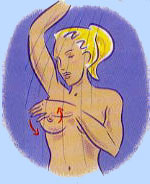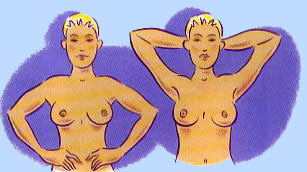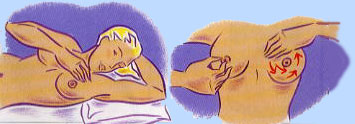Each day over 1,300 women are diagnosed with breast cancer in the UK. It is the most common cancer in women. In this article we examine the disease and how you can take positive steps to prevent breast cancer.
Breast Cancer Information
There are over 100 million small building blocks or cells that make up the body’s organs and tissues. Cancer is the result of something going awry in only one of these cells. Even though the various parts of the body have cells that operate and look differently, their job is to mostly repair, and reproduce themselves in a similar fashion. This cell division usually occurs in a controlled way. However if the process goes awry, the cells continue to divide which produces a lump often called a tumour. These tumours can be malignant or benign.
When this procedure begins in the cells which make up the glandular breast tissue, the tumour is called breast cancer.
Breast cancer is a complicated ailment that has numerous types and treatments. We are constantly discovering more about cancer daily – ways to identify it early on, what treatment options are offered and most significantly, ways to cure it. As with every situation, the earlier a cancer is detected the better likelihood there is of a full recovery.
Risk Factors
While any woman can develop breast cancer, some risk factors increase the chance of developing the disease:
Gender – Breast cancer overwhelmingly affects women though men can also get the disease. Out of every 100 breast cancers diagnosed, 99 occur in women.
Age – Two out of three invasive breast cancers are found in women age 55 or older. Risk increases with age due to longer exposure to cancer promoters like estrogen.
Genetics – Five to ten percent of breast cancers result directly from gene mutations passed down through families. Having a first-degree female relative (mother, sister, daughter) diagnosed increases risk.
Reproductive history – Women who began menstruating early or underwent menopause after age 55 have a higher lifetime exposure to estrogen and increased risk. Never giving birth or older age at first full-term pregnancy also heighten risk.
Dense breast tissue – Having more gland tissue and less fatty breast tissue can make cancer detection via mammograms more difficult and is linked to increased risk.
Previous breast cancer diagnosis – Having one breast cancer diagnosis substantially increases the chance of developing cancer in the other breast.
Radiation therapy – Past treatment involving high dose radiation to the chest area, as for lymphoma, increases breast cancer risk later in life.
Hormone replacement therapy – Use of combined estrogen plus progestin HRT for over five years modestly elevates breast cancer risk in postmenopausal women.
Obesity – Being overweight or obese after menopause is tied to a higher chance of getting breast cancer, especially in women who have never used HRT. The extra fat tissue produces estrogen.
Alcohol consumption – Consistently having more than one alcoholic drink per day appears to slightly raise breast cancer odds in women. Lower intake has less defined risk.
Physical activity level – Women who are physically inactive throughout life may have a 20% higher risk of breast cancer diagnosis versus very active women, based on research.
Knowing risk factors allows women and healthcare providers to be proactive about screening and prevention. But many breast cancers also arise in women who have no obvious risk factors other than being female and growing older. Regardless of risk, awareness of personal breast health is vital.
How Do I Detect Breast Cancer?
It is vital that all women pay attention to and be conscious of her breasts all through her life. Breast measurements and shape differ significantly from one woman to another and so does nipple configuration. Breast self-awareness is essential; by checking your breasts frequently you will understand what is typical for your own body and can identify changes immediately. Keep in mind, there are several things that could cause them to feel different at specific times of the month such as your menstrual cycle, right before your period breasts often tend to be a bit sensitive and feel lumpy.
When and How Should I Do My Breast Check?
You need to examine your breasts every month from age 18. Most women experience changes in their breasts before their period. They could feel tender or lumpy and then right after feel soft, therefore this is a great time to examine your breasts. Post-menopausal breasts often feel soft and somewhat less lumpy.
When you are aware of your breasts you can quickly identify any changes.
In the Shower/ Bath

Fingers move better on wet skin. Lift up your left hand and with the flat part of your hand gently move over both breast in a circular movement. Look for any lump, tough knot or thickening. Try not to squeeze or poke your breasts. It is equally important to feel around your collarbone and underarm to feel for swellings or lumps.
In Front of a Mirror

Place your hands on your hip area and push inwards until the chest muscles clench. This makes any changes more pronounced. Next, place your hands on top of your head and search for skin dimples or bulges, especially under your breast. Dimples which are even in both breasts are often safe. Lift your hand above and search again for variations. Look closely at your breasts from all positions from the side, underneath and bending forward.
Lying Down

Put a pillow underneath your left shoulder and place your left hand over your head. Use a circular motion to examine your breast. Keep an eye out for puckering, change in nipple direction, orange peel skin or if the dark skin around the nipples are swollen. Do the same for the right side. Squeeze both nipples to check for discharge. When you are doing your self-examination, look out for these things:
- Any alteration of the size or appearance of the breast – it could be one breast is now clearly bigger or lower.
- The nipple turns inward – it gets inverted.
- The shape or the position of the nipple has changed.
- A lump or swelling in your underarm.
- A blood-stained emission – this is an extremely unusual symptom.
- A rash on a nipple area (also extremely rare).
- Veins which stick out more than regular.
- Soreness in your breast you have not felt previously.
If there are any of the above signs of changes in your breast, go see your doctor immediately.
What Else Could Result in Lumps or Pain in the Breast?
The great news is that around 90% of lumps not cancer related are often benign. Breast problems can be painful sometimes, but they can be easily treated fairly quickly. The two kinds of lumps common in women are:-
Cysts – which are lumps filled with fluid, and can differ in dimension. Usually they are taken out if they become painful; however they often shrivel without requiring treatment.
Fibro-adenomas – which are solid pain-free lumps, comprised of fibrous and glandular matter. These lumps can easily be removed surgically should they become uncomfortable.
Breast pain, often called mastalgia, is a typical issue that the majority of women encounter at some stage of their lifespan. This often occurs before their period and is treatable by a medication, from your physician. Like with every breast issue it is wise to report any kind of lumps or pains to your physician.
Am I at Risk of Getting Breast Cancer?
Breast cancer can happen at any age, however around 90% of women with breast cancer are over the age of 45. Breast cancer is unusual in women under 40 years old. Breast cancer can happen to anyone, including males. Each year, 200 males are identified as having breast cancer; therefore men should also report any kind of breast variations to their physician.
Women are at greater risk if 2 or more relatives had breast cancer. The degree of risk is amplified if their mother or sister got the disease before age 50.
Research indicates that the contraceptive pill and H.R.T. could cause a minor rise in women getting breast cancer; this threat is minimised if they stop taking the pill.
Women that begin their periods at a young age or women who have a delayed menopause possibly have a higher chance of breast cancer.
What Can I Do to Minimise My Risk of Breast Cancer?
A common suggestion for a healthier way of life is frequent exercise and staying with a nutritious, balanced eating plan. Eliminate alcoholic beverages, should you choose to drink – be sure to stay within the suggested amounts. For women it is 2 to 3 units a day and for males 3 to 4 units a day. This quantity of alcohol shouldn’t increase your health risk (click here for additional info on alcohol).
The best means of minimising your risk of every cancer and disease is to quit smoking. Regardless of your current age, employing the suggested self-awareness plan (above) is a method you can utilise often.
How Is Breast Cancer Diagnosed?
Breast Screening is able to pick up cancers at an initial phase in their growth and usually before they could be sensed by the woman. Once breast cancer is discovered early on, there is a much better possibility of effective treatment. Breast Screening, often called a mammography, entails getting X-rays of both breasts. The X-rays are subsequently checked for any indications of cancer or additional irregularities. A regular X-ray is available for women over 50. You might be offered screening even earlier, if you have a history of breast cancer in your family.
If you find a lump in your breast an you are under 50 years old, your physician may advise that you get a mammography or an ultrasound scan. These checks can often identify if the lump is malignant or simply a cyst. You can even have part or the entire lump taken out, which is called a biopsy. When taken out, the physician will analyse the lump under a microscope to check if some of the cells are cancerous.
How Is Breast Cancer Treated?
The great thing is that statistics during the last couple of years have made breast cancer, a familiar, however not a fatal disease. Research has indicated that 84% of females who discovered breast cancer early (prior to it spreading), could have an excellent opportunity for full recovery.
When breast cancer is detected, you will have many solutions to choose from. The solutions available depend on your age, overall health, the kind of cancer and how much it has spread.
When the tumour is minor you might only need surgical treatment to remove the lump or a portion of the breast. This surgery is usually followed by radiotherapy, to ensure that all cancer cells are killed. For the majority of women this minor procedure is often the only thing that is required. But, if the tumour is too large or has spread, a mastectomy might be more appropriate. A mastectomy is the full removal of the breast. Chemo treatment is often suggested. Your physician will go over all choices with you.
Help and Advice
Breast Cancer UK is a leading charity aimed at saving lives by primary prevention of breast cancer. Their website is very useful and offers advice as well as information and fundraising ideas. They also publish some easy steps on reducing your risk of breast cancer.
Cancer Research UK also works tirelessly to raise money for work in the area of cancer prevention. The breast cancer section of their website is informative and comprehensive. The fundraising efforts of this charity have also been very helpful in raising both money and awareness.
Photo by Anthony Cunningham for Zoom Health UK
Zoom Health is a leading UK supplier of Home Health Tests and Earplugs
This post was originally published in 2020. It was last updated in January 2025.





